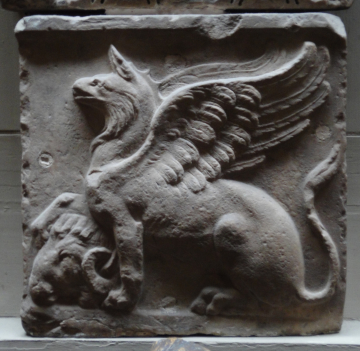Explore Collections


You are here:
CollectionsOnline
/
End of a sarcophagus: griffin and ram's head
Browse
Curatorial note
A lion-pawed Griffin sits facing left, right forepaw on the severed head of a ram facing in similar direction. From the right end (facing the main panel) of a rectangular sarcophagus; the plain-fillet, overhanging top moulding is visible above.
Although of a continually used style, this piece is probably work of the later Antonine period. The end of this sarcophagus can be compared to a slightly later example in the Museo Capitolino1; it is thought that it and its pair formed the ends to the Meleager sarcophagus, which is dated to the end of the second or beginning of the third century AD.
The griffin, as the attribute of Apollo, may be connected with almost any sarcophagus front depicting subjects involving the solar cycle, the myths of death and rebirth, and, consequently, eternity. Lehmann-Hartleben and Olsen conclude that the griffin as an animal of divinity symbolised apotheosis and drew the chariot of the deceased towards heaven or carried him as a rider and note that 'As such, the griffins had at a very early date entered into the sphere of Bacchic symbolism'.2 They show that this widespread motive of a griffin placing his claw or paw on the detached head of a ram or a goat, an animal sacred to Dionysos, can be frequently connected with the popular cult of the god Dionysos-Sabazios. On the end of the Griffin Sarcophagus in Baltimore3, the ram's head lies on the ground beneath a heraldically springing Panther-Griffin: a similar motive connected with the mysteries of Dionysos worship.
This piece is shown in a watercolour capriccio of works in Soane's collection, c.1825, Vol. 82_86.
1 The British School at Rome, Catalogue of ancient sculptures preserved in the municipal of Rome: The sculptures of the Museo Capitolino, ed. H.S. Jones, Oxford, 1912, p.262, no. 103, pl. 63; also p. 261, no. 101, the other end; and p. 270, no. 119, the front.
2 K. Lehmann-Hartleben and E.C. Olsen, Dionysiac Sarcophagi in Baltimore, Baltimore, M.D., 1942, pp. 30-31, 45-46.
3 K. Lehmann-Hartleben and E.C. Olsen, Dionysiac Sarcophagi in Baltimore, Baltimore, M.D., 1942, fig. 17.
Although of a continually used style, this piece is probably work of the later Antonine period. The end of this sarcophagus can be compared to a slightly later example in the Museo Capitolino1; it is thought that it and its pair formed the ends to the Meleager sarcophagus, which is dated to the end of the second or beginning of the third century AD.
The griffin, as the attribute of Apollo, may be connected with almost any sarcophagus front depicting subjects involving the solar cycle, the myths of death and rebirth, and, consequently, eternity. Lehmann-Hartleben and Olsen conclude that the griffin as an animal of divinity symbolised apotheosis and drew the chariot of the deceased towards heaven or carried him as a rider and note that 'As such, the griffins had at a very early date entered into the sphere of Bacchic symbolism'.2 They show that this widespread motive of a griffin placing his claw or paw on the detached head of a ram or a goat, an animal sacred to Dionysos, can be frequently connected with the popular cult of the god Dionysos-Sabazios. On the end of the Griffin Sarcophagus in Baltimore3, the ram's head lies on the ground beneath a heraldically springing Panther-Griffin: a similar motive connected with the mysteries of Dionysos worship.
This piece is shown in a watercolour capriccio of works in Soane's collection, c.1825, Vol. 82_86.
1 The British School at Rome, Catalogue of ancient sculptures preserved in the municipal of Rome: The sculptures of the Museo Capitolino, ed. H.S. Jones, Oxford, 1912, p.262, no. 103, pl. 63; also p. 261, no. 101, the other end; and p. 270, no. 119, the front.
2 K. Lehmann-Hartleben and E.C. Olsen, Dionysiac Sarcophagi in Baltimore, Baltimore, M.D., 1942, pp. 30-31, 45-46.
3 K. Lehmann-Hartleben and E.C. Olsen, Dionysiac Sarcophagi in Baltimore, Baltimore, M.D., 1942, fig. 17.
Unrecorded.
Literature
A. Michaelis, Ancient Marbles in Great Britain, trans. C.A.M. Fennell, Cambridge, 1882, p. 480, no. 33.
Associated items
Vol 82/86, watercolour showing this item
Soane collections online is being continually updated. If you wish to find out more or if you have any further information about this object please contact us: worksofart@soane.org.uk


